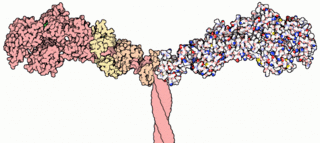Myosin VI, also known as MYO6, is a protein. It has been found in humans, mice, fruit flies ( Drosophila melanogaster ), and nematodes ( Caenorhabditis elegans ).
Myosin VI, also known as MYO6, is a protein. It has been found in humans, mice, fruit flies ( Drosophila melanogaster ), and nematodes ( Caenorhabditis elegans ).
Myosin VI is a molecular motor involved in intracellular vesicle and organelle transport. It is one of the so-called unconventional myosins.[supplied by OMIM] [5]
MYO6 has been shown to interact with GIPC1, [6] [7] DAB2., [8] [9] ubiquitin, [10] and clathrin [11]

Endocytosis is a cellular process in which substances are brought into the cell. The material to be internalized is surrounded by an area of cell membrane, which then buds off inside the cell to form a vesicle containing the ingested material. Endocytosis includes pinocytosis and phagocytosis. It is a form of active transport.

Myosins are a superfamily of motor proteins best known for their roles in muscle contraction and in a wide range of other motility processes in eukaryotes. They are ATP-dependent and responsible for actin-based motility. The term was originally used to describe a group of similar ATPases found in the cells of both striated muscle tissue and smooth muscle tissue. Following the discovery by Pollard and Korn (1973) of enzymes with myosin-like function in Acanthamoeba castellanii, a global range of divergent myosin genes have been discovered throughout the realm of eukaryotes.

Clathrin is a protein that plays a major role in the formation of coated vesicles. Clathrin was first isolated and named by Barbara Pearse in 1976. It forms a triskelion shape composed of three clathrin heavy chains and three light chains. When the triskelia interact they form a polyhedral lattice that surrounds the vesicle, hence the protein's name, which is derived from the Latin clathrum meaning lattice. Coat-proteins, like clathrin, are used to build small vesicles in order to transport molecules within cells. The endocytosis and exocytosis of vesicles allows cells to communicate, to transfer nutrients, to import signaling receptors, to mediate an immune response after sampling the extracellular world, and to clean up the cell debris left by tissue inflammation. The endocytic pathway can be hijacked by viruses and other pathogens in order to gain entry to the cell during infection.

Myosin VIIA is protein that in humans is encoded by the MYO7A gene. Myosin VIIA is a member of the unconventional myosin superfamily of proteins. Myosins are actin binding molecular motors that use the enzymatic conversion of ATP - ADP + inorganic phosphate (Pi) to provide the energy for movement.

Myosin-Va (MYO5A) is a motor protein in charge of the intracellular transport of vesicles, organelles and protein complexes along the actin filaments. MYO5A gene encodes for the unconventional Myosin motor Va.

Disabled homolog 2 is a protein that in humans is encoded by the DAB2 gene.

AP-1 complex subunit mu-1 is a protein that in humans is encoded by the AP1M1 gene.

Dynamin-1 is a protein that in humans is encoded by the DNM1 gene.

WAS/WASL-interacting protein family member 1 (WIP) is a protein that in humans is encoded by the WIPF1 gene.

MYO9B is a gene that encodes the Myosin-IXb protein.

Myosin-Ic is a protein that in humans is encoded by the MYO1C gene.

Myosin X, also known as MYO10, is a protein that in humans is encoded by the MYO10 gene.

Myosin-Ia is a protein that in humans is encoded by the MYO1A gene.

Myosin-XVIIIa is a protein that in humans is encoded by the MYO18A gene.

Myosin-Vb, a myosin V type protein, is encoded by the MYO5B gene in humans.

Myosin IIIA is a protein that in humans is encoded by the MYO3A gene.

Myosin-Ib is a protein that in humans is encoded by the MYO1B gene.

Myosin-If is a protein that in humans is encoded by the MYO1F gene.

Myosin-XVIIIb is a protein that in humans is encoded by the MYO18B gene.

Myosin-Ie (Myo1e) is a protein that in humans is encoded by the MYO1E gene.
| | This article on a gene on human chromosome 6 is a stub. You can help Wikipedia by expanding it. |